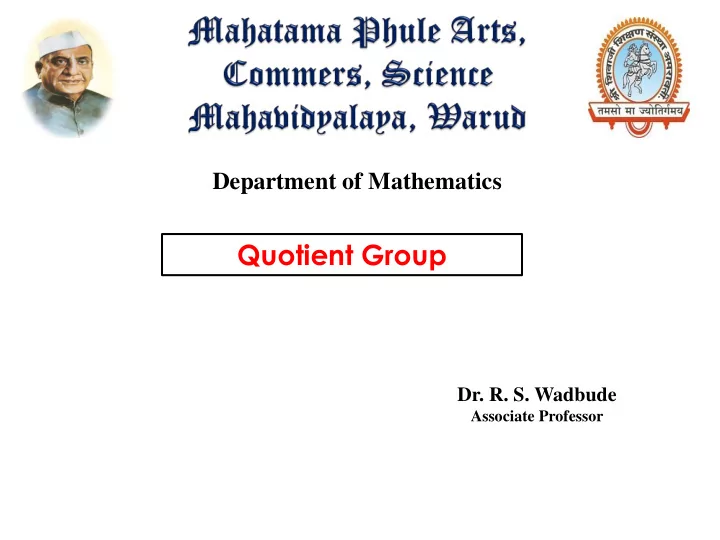

Department of Mathematics Quotient Group Dr. R. S. Wadbude Associate Professor
Co-sets Normal Sub-Group Quotient Group Lagrange’s Theorem
Coset a Group Sub-Group (H) h 1.Under Addition a) Left Coset : a+H={a+h : h H} b) Right Coset : H+a= {h+a : h H} 2. Under Multiplication G a) Left Coset : aH={ah : h H} b) Right Coset : Ha= {ha : h H}
Normal Sub-Group A sub-group N of G is called normal Sub- group of G if for every g G and for every n N , we have gng -1 N. Condition : gng -1 N g G, n N 1. gNg -1 N g G 2. g G gNg -1 = N 3. g G 4. gN = Ng a, b G 5. NaNb = Nab
Quotient Group • Let N be a normal subgroup of a N group ‘g’ and the set (Normal Sub- G/N = {Na : a G} group) Na is collection of distinct right co-sets of N in G under multiplication the G/N is Quotient group or factor group. G
Example : Let Z be an additive group of integers and let N be subgroup of Z defined by N = { nx x Z}, where n is a fixed integer. Construct the quotient group Z/N. Also prepare a composition table for Z/N, when n=5. Solution :- An additive group Z of integer is abelian. Then its subgroup N is a normal subgroup. We have Z= {0, 1, 2, … }, the elements of a quotient group Z/N are the cosets which are as under. = {0, n, 2n, … } N Now N+0 = {0, 0 n, 0 2n, … }= N N+1 = {1, 1 n, 1 2n, … } N+2 = {2, 2 n, 2 2n, … } … . … . N+(n-1) = {n-1, 2n-1,3n-1,-n-1, … }
…}={0 2n,…} =N similarly one can show that N+(n+1) = N+1 N+(n+2) = N+2 i Z i.e. N+(n+ i )= N+ i Z/N = { N,N+1,N+2,…N+(n -1) } Hence N= {0 5, 10,…} For n=5: The distinct cosets will be N,N+1,N+2,N+3,N+4. The composition table is
N N+1 N+2 N+3 N+4 N N N+1 N+2 N+3 N+4 N+1 N+1 N+2 N+3 N+4 N N+2 N+2 N+3 N+4 N N+1 N+3 N+3 N+4 N N+1 N+2 N+3 N+4 N+4 N N+1 N+2
Lagrange’s Theorem If G is a finite group and H is a subgroup of G, then o(H) is a divisor of o(G). o(G)/o(H) i.e.
Example : If G = {a, a 2 , a 3 , a 4 , a 5 , a 6 = e}is a group of H={a 3 , a 6 = e} is its normal subgroup, then write G/H . Solution : Here the distinct cosets of H in G are eH = {e.a 3 ,e.e} = {a 3 ,e} = H aH = {a.a 3 , a.e} = {a 4 ,a} a 2 H= {a 2 .a 3 , a 2 .e} = {a 5 , a 2 } a 3 H= {a 3 .a 3 , a 3 .e} = {a 6 , a 3 }= {e,a 3 }= H a 4 H= {a 4 .a 3 , a 4 .e} = {a, a 4 }= aH a 5 H= {a 5 .a 3 , a 5 .e} = {a 2 , a 5 }= a 2 H . In this way we obtain only three distinct cosets H,aH, a 2 H of H in G. Hence G/N = {H,aH, a 2 H}.
Example : If G = < a >is a cyclic group of order 8, then the quotient group corresponding to the subgroup generated by a 2 and a 4 respectively. Let, G= {a,a 2 ,a 3 ,a 4 ,a 5 ,a 6 ,a 7 ,a 8 = e} Solution : H 1 = {a 2 ,a 4 ,a 6 ,a 8 = e} and H 2 = {a 4 ,a 6 ,a 8 = e} Since , G is abelian, therefore the subgroups H 1 and H 2 are normal in G. o(G/H 1 )= 8/4=2, o(G/H 2 ) = 8/2= 4 G/H 1 = { H 1 , H 1 a}, where H 1 a = {a 3 ,a 5 ,a 7 ,a} {H 1 a 3 = H 1 a, H 1 a 2 = H 1 a 4 = H 1 a 6 =H 1 a 8 = H 1 } etc. G/H2 = {H 2 ,H 2 a, H 2 a 2 , H 2 a 3 }.
THANK YOU
Recommend
More recommend